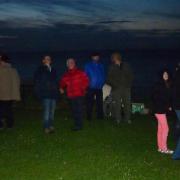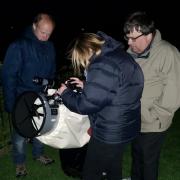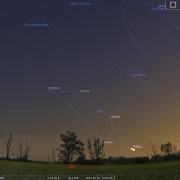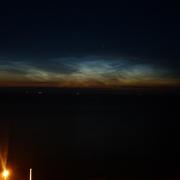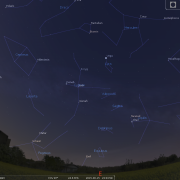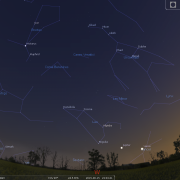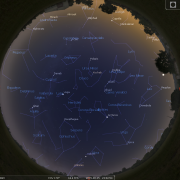Welcome to the WDAS monthly newsletter for June 2015: a digest of the month's latest contributions to our website. Below you'll find Society News, Sky Notes and In-Focus articles printed in full. There's also future events, and trailers for other articles which appear in full on the website - just a click away!
On the website you'll also be able to comment on articles, and if you'd like to play an editorial role in creating new content, just let us know!
Society News
Perhaps not a first, but at least opening star party event of the summer season on May 23rd went ahead in pretty decent conditions, with just a little cloud around the horizon. With five scopes deployed and eight members present, the most was made of the bright twilight conditions that prevail at this time of year. A lovely waxing crescent moon, the planets; Venus and Jupiter and Saturn and finally some of the brighter stars, made it an enjoyable evening, certainly plenty of ‘goodies’ to keep a quite sizeable and interested crowd at the eyepieces for a couple of hours.
|
Star Party on West Cliff, Sat 23-May-2015
Photo taken by Mark Dawson |
Star Party on West Cliff, Sat 23-May-2015 |
As the sun went down, the moon proved the initial draw, then a game of ‘spot the planet’ ensued, naturally Venus won hands down. Jupiter then followed, and with four moons visible it proved a hit with the crowd, more so than Saturn, which although became visible later, was also considerably effected by rising turbulence, making the image somewhat unsteady. Saturn’s time will come.
All in all, not a bad way to spend an evening under the stars, planets and seagulls.
Weather permitting; we are planning to host around twenty star parties over the outdoor summer season. Some, (and if past history is anything to go by ) many, will fall victim to our fickle British weather, so do not be surprised if several unscheduled star party events are added, making the best of conditions on that night. Mark will ring or e-mail those of you likely to attend at short notice, and if you cannot make it... no worries. I am sure we will see you at some of the planned events.
Sometimes the unscheduled events are those enjoyed most, and as proved on countless occasions W.D.A.S members who regularly support star parties will testify (electrodes, needles and large dogs were not used to extract this information) how rewarding these can be. All that is required is a fine evening, a curious public (some of which may, or may not have been abducted by aliens...according to them) and the scopes.
Assistance is always welcome - actually it's becoming a necessity, even it's just to lend a hand in setting up equipment and keeping a watchful eye on things. So if you can make it along, please do join us.
In-Focus
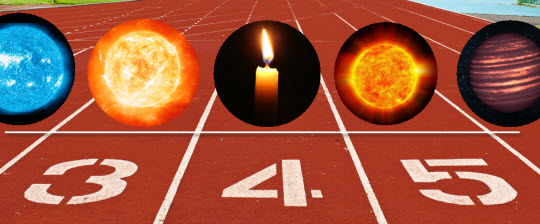
The Great British Summer - cool and showery, now’t on telly, rusting barbecues, light nights, idle scopes, humid days, lobster people and thundery downpours... and more light nights. From the latitude of ‘god’s own country’ astronomical twilight is actually absent for 82 nights over the summer and only the brighter stars are readily visible before 11pm. Indeed, for a fortnight either side of the summer solstice many of the fainter stars normally visible, are so for only a few hours, if at all. Bright or faint, stellar brightness is quantified in different ways.
I trust even the most casual of observers notice that to the naked eye not all stars are alike–either in brightness or colour. The brightness of any celestial object is expressed in terms of magnitude, a classification system that can be traced back to the 1st century AD to the great astronomer Ptolemy and then revised by Hipparchus a century later into six classes of brightness. Our present day system was formalised in 1860, when the Astronomical Union decided that a half-pound plumbers candle seen from a distance of 1 mile was found to be equivalent in brightness to many of the brighter stars visible. Hence such stars were considered to be of the first magnitude.
The scale of stellar brightness works in similar fashion to that of a golfer’s handicap, with the most brilliant performers having the lowest values. Each magnitude class is separated by a factor of 2.5 orders e.g. a second magnitude star is 2.5 times fainter than a first magnitude star. A third magnitude stars is 2.5 times fainter than a second magnitude star and so on. A star of sixth magnitude, the generally accepted naked eye limit from dark rural sites, is thus 100 times fainter than a star of the 1st magnitude.
The most brilliant stars visible have an apparent brightness expressed in negative terms. Two may be seen from the UK; Sirius, the brightest star in the night sky (now set) and Arcturus (-0.04), which is located high to the SE as darkness falls. By convention there are 21 stars of the first magnitude in the heavens ranging from Sirius, Mag -1.46 to Regulus +1.35. Stars from +1.5 to +2.5 are counted as second magnitude stars, 2.5 to 2.5 as third magnitude, and so on. Of the 21 brightest stars ranged across the heavens, 15 are visible from the UK at some time during the year.

Absolute v. Apparent Magnitude of selected stars, planets and the Moon. (Planets
only have an Apparent Magnitude, varying with crescent and our varying distance from them.)
The same magnitude system also applies to other celestial bodies. Venus, which was so dominant over the winter, can attain Mag - 4.6. Jupiter regularly reaches Mag -2.5, as too can Mars on rare occasions. A full moon reflects sunlight equivalent to Mag -13, whilst the Sun baths our world in ‘factor’ –27, that’s 400,000 times brighter than a full moon or 10 billion times brighter than Sirius!

Stars in the Constellaton Canis Major: Sirius
is giant in appearance but a baby in practice.
Image Credit: SkyAndTelescope.com
Apparent magnitude only tells part of the story; astronomers regard the measurement of Absolute Magnitude as far more informative about what a star is really like. It is human nature to perceive the celestial dome as a two dimensional canvas and we often fail to appreciate that stars are scattered throughout space at hugely varying distances and luminosities.
Apparent brightness is just that – apparent – and bears no relation to true luminosity. A star may appear bright by virtue of being situated relatively nearby, whereas visually fainter, more distant stars may in comparison be considerably more luminous. In an effort to make scientific sense of all this, astronomers use an Absolute Magnitude scale to gauge the real luminosity of any star. This assumes a standard distance for all stars equivalent to10 parsecs or 32.6 light years. One parsec (Named from an abbreviation of the parallax of one arc second ) is the distance at which one astronomical unit (AU, the distance from the Earth to the Sun) subtends an angle of one arc second. A parsec is equal to about 3.26 light-years (31 trillion kilometers or 19 trillion miles) in length.

Using this method our own brilliant Sun would have an absolute magnitude of +4.2, not so brilliant after all, hardly noticeable in a sky adorned with sparkling luminaries. On the other hand our pole star – Polaris, which is of second magnitude, would appear to rival Venus (mag -4.4) if located at 10 parsecs.
A few of our brighter summer luminaries: Vega, Capella and Arcturus would still appear similar in brilliance, others would most definitely not. Some stars are ‘born special’ and are really luminous. Deneb for instance, in the constellation of Cygnus is an extreme example of this scenario. Visually, Deneb makes it into the stellar top 20 and yet it is far more remote than the majority of brighter stars visible. If Deneb were situated just 10 parsecs away it would blaze forth at Mag -8, twice as bright as Venus appears. Casual stargazers might marvel at Alpha Cygni, but seasoned astronomers, especially from these latitudes where Deneb is visible all year round, would soon tire of its radiance, severely restricting deep sky observations.
This begs the question, what would astronomers in the close proximity of such a brilliant luminary make of their cosmos? Perhaps on reflection our Sun and this planet are ideally placed to study and appreciate the boundless universe and marvel at the magnitude of it all!
Sky Notes
In this month's Sky Notes:
Planetary Skylights
 Look to the WNW to find both Venus (left) and Jupiter dominating the late evening twilight sky. At Mag-4.4, Venus is considerably the brighter and at the start of June (2nd) lines up with Castor and Pollux in Gemini. It then passes just above the open star cluster (M44); the Beehive in Cancer on the 12th & 13th.
Look to the WNW to find both Venus (left) and Jupiter dominating the late evening twilight sky. At Mag-4.4, Venus is considerably the brighter and at the start of June (2nd) lines up with Castor and Pollux in Gemini. It then passes just above the open star cluster (M44); the Beehive in Cancer on the 12th & 13th.
 Jupiter and Venus continue to close the gap between them resulting in a spectacular planetary conjunction at the end of June when they are separated by less than one degree in the sky. A modest scope at low power should show both in the same field of view, with Jupiter's Galilean moons (3 on one side and Ganymede on the other) strung out in a line. Venus will appear as a half phase. The young moon lies near both on the 20th, making for a splendid sight.
Jupiter and Venus continue to close the gap between them resulting in a spectacular planetary conjunction at the end of June when they are separated by less than one degree in the sky. A modest scope at low power should show both in the same field of view, with Jupiter's Galilean moons (3 on one side and Ganymede on the other) strung out in a line. Venus will appear as a half phase. The young moon lies near both on the 20th, making for a splendid sight.
 Saturn is making inroads into the evening sky, located low in the SE and to the south by midnight. Saturn resides not that far above the distinctive ‘ruddy’ hue of Antares, chief star in Scorpius. Viewed through a scope Saturn is a glorious spectacle, with the ring system now wide open, the only down side being the relatively low altitude above the horizon which often makes for poorer seeing. Saturn's largest moon; Titan, is visible as a speck close by. Our moon lies nearby on the 1st and also the 28th.
Saturn is making inroads into the evening sky, located low in the SE and to the south by midnight. Saturn resides not that far above the distinctive ‘ruddy’ hue of Antares, chief star in Scorpius. Viewed through a scope Saturn is a glorious spectacle, with the ring system now wide open, the only down side being the relatively low altitude above the horizon which often makes for poorer seeing. Saturn's largest moon; Titan, is visible as a speck close by. Our moon lies nearby on the 1st and also the 28th.
Meteor Activity

The weak Ophiuchid meteor shower has two maxima, June 9th and June 20th. The zenith hourly rate (ZHR) barely exceeds sporadic levels (5 - 8 per hr) Observe post midnight. The poorly observed June Lyrids peak on the 15th/16th, again the ZHR is only 5-6 per hour.
Summer Solstice

"Whitby Abbey Summer
Solstice" (taken June 2014)
Reproduced with kind
permission: Si's Photography
Click for full-sized image.
Oh dear, half the year misplaced already, and we are rapidly approaching the summer solstice, which falls on June 21st. Before we know it, days will grow shorter and nights longer again! In the northern hemisphere the solstice officially marks the start of summer even though we are almost into the seventh month!
Derived from the Greek for 'sun' and 'to stand still', the solstice (summer) marks the precise time the Sun seemingly halts its movement northwards in the sky, attaining its greatest altitude on the ecliptic; the path the Sun follows across the sky during a year. From our latitude this equates to almost 59 degrees above the southern horizon. Thereafter, the Sun retreats southwards once again as the axial tilt of Earth shifts away from the direction of the Sun.
Because temperatures are warmer in summer many people wrongly assume that Earth is closer to the Sun at this time of year; in fact the opposite is true. Earth is actually furthest from the Sun on July 4; almost 95 million miles distant, three million miles further than when at its closest approach in early January!
The reason days feel warmer in summer is due to the higher concentration of sunlight per unit area, caused by the axial tilt of the Northern hemisphere toward the Sun. On average the intensity of solar radiation is then equivalent to approximately 1.2KW of heat for each square metre, although it can sometimes feel we're being short changed!
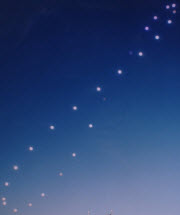
Analemma: Sun's position at
same time of day over a year.
Earth's tilt+eliptical orbit mean
longest day, earliest sunrise
& latest sunset don't coincide.
The summer solstice is also known as the longest day, however earliest sunrise and latest sunset do not occur on this date. From Whitby earliest sunrise actually occurs on June 16th at 04:25am, whilst latest sunset occurs on June 25th at 21:42pm. It is the duration of use able daylight that does reach a maximum on the 21st, which from here amounts to just over 17 hours. With the Sun dipping barely 12 degrees below the horizon, it's no wonder nights are so light, even nautical twilight is relatively short lived. Any place north of the Arctic Circle will see the sun above the horizon for 24hrs, indeed it was rather interesting to note how the background twilight levels varied during the Eurovision voting jury segment. Certainly, background skies from Scandinavian countries were a good deal lighter, making it looks as though they were voting earlier in the day.
Thousands of years ago the position of the summer solstice in the northern hemisphere stood before the stars of Cancer, but has subsequently shifted due of the effects of precession, Earth's slow axial wobble and now stands on the Gemini/ Taurus border. Anywhere on the Earth's surface between latitude 23.5 degrees North and latitude 23.5 degrees South,, the Sun can appear overhead, casting no shadows, a phenomena astronomers in antiquity duly noted.
Because the summer solstice then stood before Cancer, the latitude of 23.5 degrees north eventually became known as the tropic of Cancer. Similarly, as the Sun then stood before the stars of Capricorn at its southern limit on the ecliptic, (the winter solstice) some 23.5 degrees south of the celestial equator, the same latitude on the Earth became known as the tropic of Capricorn. So, rejoice summer is almost upon us, time to don a druids cloak and go and admire some large standing stones.. if that’s your thing.
With bright twilight now persisting well into the night, observers of the sky may like to keep an eye open for a particularly beautiful type of cloud formation seen only at this time of year. Known as Noctilucent cloud, these delicate formations appear in the twilight sky above the northern horizon, long after sunset, even after midnight. Shining quite brightly, Noctilucent cloud is filamentary in structure, having a characteristic silvery-blue colour.
It forms almost exclusively between latitudes 50 and 60 degrees north, high in the upper atmosphere: 50 miles up- five times higher than normal clouds. The cloud forms when water vapour condenses at the low temperatures that prevail at such altitudes onto particles suspended in the air. More frequent sightings of Noctilucent cloud over the last 40 years may indicate that these particles could be a result of industrial pollution, perhaps from increased air traffic.
As far as observers of the sky are concerned, the right type of cloud, for the wrong reasons! Certainly, some of my observing highlights the past two summers have been displays of Noctilucent cloud so do keep a watch!
|
Looking South
Mid June - 23:00h |
Looking North |
|
Looking East
Mid June - 23:00h |
Looking West
Mid June - 23:00h |
|
|
|
|
Overview
Mid June - 23:00h |
|
Additional Image Credits:
- Planets and Comets where not otherwise mentioned: NASA
- Sky Charts: Stellarium Software

